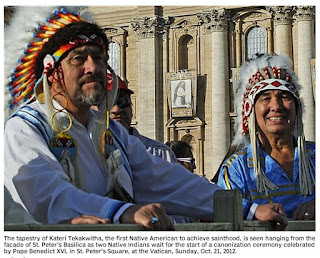We're about a week away from the month that the President of the United States designates as Native American Month. Below are suggestions on how you might get your library ready for parents, teachers and students who come into your library looking for materials on American Indians.
In this post, you'll find links to ALA's READ posters that feature Sherman Alexie, author of THE ABSOLUTELY TRUE DIARY OF A PART TIME INDIAN. You'll also find links to the Indigenous Languages Development Institute, where you can buy a wall clock with numerals in a Native language, and READ posters in Indigenous languages, available from the Tulsa American Indian Resources Center:
Creating a Library Atmosphere that Welcomes American Indians:
http://americanindiansinchildrensliterature.blogspot.com/2012/10/creating-library-atmosphere-that.html
In these posts, you'll find recommended books about American Indians, by age group:
Top Board Books
http://americanindiansinchildrensliterature.blogspot.com/2011/04/top-board-books-for-youngest-readers.html
Top Ten Books for Elementary School
http://americanindiansinchildrensliterature.blogspot.com/2010/07/top-ten-books-recommended-for.html
Top Ten Books for Middle School
http://americanindiansinchildrensliterature.blogspot.com/2010/07/top-ten-books-recommended-for-middle.html
Top Ten Books for High School
http://americanindiansinchildrensliterature.blogspot.com/2010/07/top-ten-books-recommended-for-high.html
If you want some guidance on how to help students do research on American Indians, using encyclopedias and websites, see
Resources for Projects on American Indians
http://americanindiansinchildrensliterature.blogspot.com/2007/03/resources-for-american-indian-research.html
If you're looking for books and materials about boarding schools for American Indians, here's some:
Boarding Schools for American Indians
http://americanindiansinchildrensliterature.blogspot.com/2008/02/as-more-resources-and-books-are.html
If you want guidelines on how to evaluate the content of a Native site, here's an excellent page about that:
Guidelines for Evaluating American Indian Web Sites
http://www.u.arizona.edu/~ecubbins/webcrit.html
And, if you want to develop your understandings of the ways that American Indians are not "multicultural" or "people of color", see:
We Are Not "People of Color"
http://americanindiansinchildrensliterature.blogspot.com/p/we-are-not-people-of-color.html
If you're looking for a Question/Answer book about American Indians, this one by the National Museum of the American Indian is outstanding:
Do All Indians Live In Tipis?
http://americanindiansinchildrensliterature.blogspot.com/2007/10/do-all-indians-live-in-tipis.html
Did you know that "papoose" is not the American Indian word for baby?
Papoose?
http://americanindiansinchildrensliterature.blogspot.com/2008/02/papoose.html
Did you order Louise Erdrich's newest book in the Birchbark House series? If not, do it today! Chickadee is terrific!
Louise Erdrich's Chickadee
http://americanindiansinchildrensliterature.blogspot.com/2012/08/louise-erdrichs-chickadee.html
I'll close with this:
Too many people think that American Indians died off, due to warfare and disease. When the emphasis in library displays is American Indians of the past, you inadvertently contribute to that idea. Librarians are a powerful group of people. You can help Americans be less-ignorant about American Indians.
Research studies show that American Indian students drop out at exceedingly high rates. Scholars attribute this, in part, to their experience with curricular materials in school. Materials set in the past, materials that stereotype American Indians, and materials that are factually incorrect or highly biased against American Indians, cause Native students to disengage from school. Libraries can interrupt that disengagement, or, they can contribute to it...
As human beings, we love to see reflections of ourselves and our hometowns. They can a source of pride or a boost to the self-esteem. But---that is only true if they are accurate. Native people want that, too, but American society has a long way to go to get there.
Libraries can get us there, but we'll need your help year-round, not just in November. I hope the resources I shared in this post will be ones that you spread out, all year long.
See also Creating a Library Atmosphere that welcomes American Indians
See also Creating a Library Atmosphere that welcomes American Indians





































